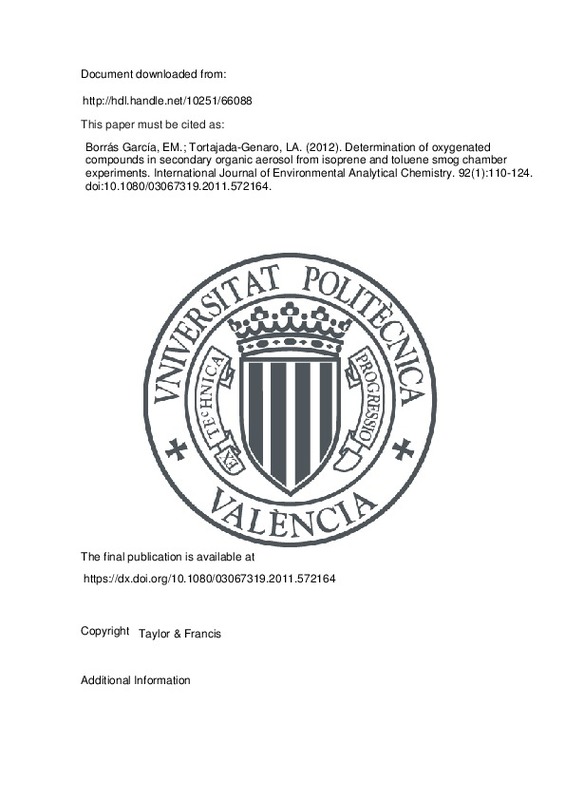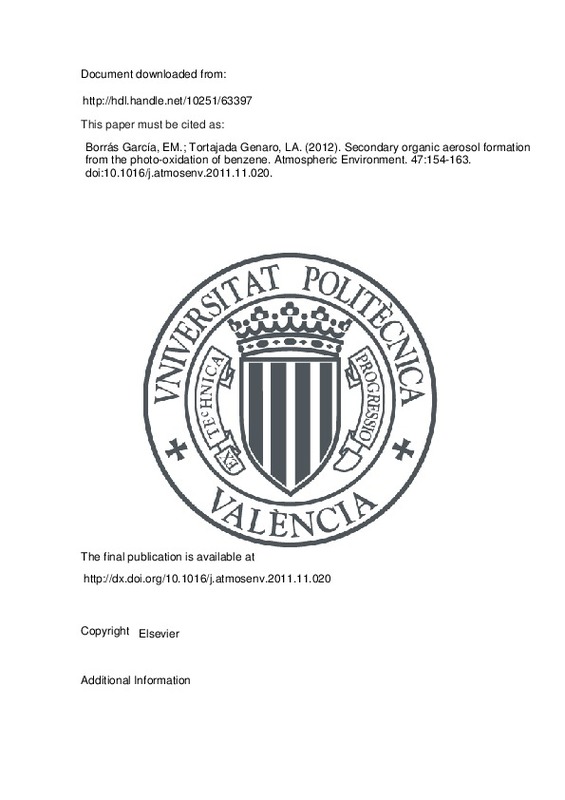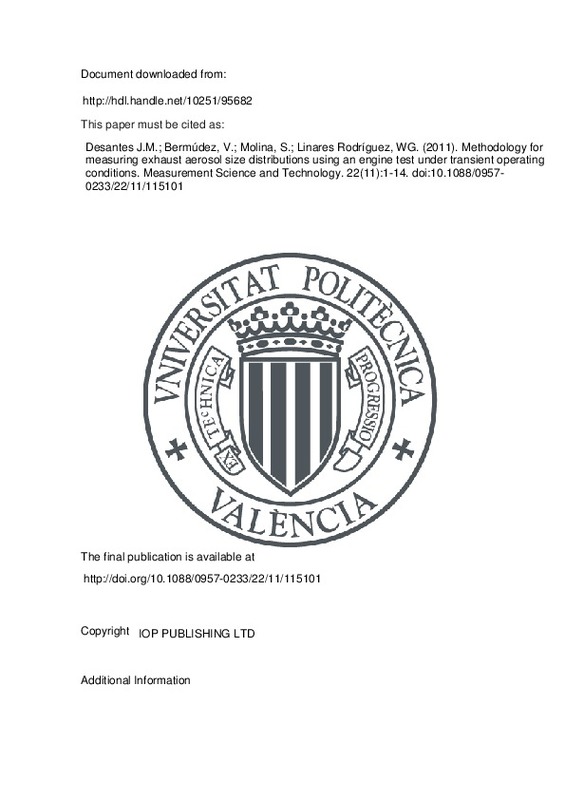JavaScript is disabled for your browser. Some features of this site may not work without it.
Buscar en RiuNet
Listar
Mi cuenta
Estadísticas
Ayuda RiuNet
Admin. UPV
Determination of oxygenated compounds in secondary organic aerosol from isoprene and toluene smog chamber experiments
Mostrar el registro sencillo del ítem
Ficheros en el ítem
| dc.contributor.author | Borrás García, Esther Mª
|
es_ES |
| dc.contributor.author | Tortajada-Genaro, Luis Antonio
|
es_ES |
| dc.date.accessioned | 2016-06-17T10:47:36Z | |
| dc.date.available | 2016-06-17T10:47:36Z | |
| dc.date.issued | 2012 | |
| dc.identifier.issn | 0306-7319 | |
| dc.identifier.uri | http://hdl.handle.net/10251/66088 | |
| dc.description.abstract | [EN] The determination of multifunctional oxygenated compounds in secondary organic aerosols (SOA) usually requires a derivatisation protocol prior to gas chromatography-mass spectrometry analysis (GC-MS). Our proposed protocol, a combination of O-(2,3,4,5,6-pentafluorobenzyl) hydroxylamine (PFBHA) plus diluted N-methyl-N-trimethyl-silyltrifluoroacetamide (MSTFA) without catalyst, has improved the determination of carbonyls, polyhydroxyl-compounds, hydroxyl- carbonyls, hydroxyl-carboxylic acids and di-carboxylic acids. The optimised derivatisation protocol has been successfully used for blanks, standard mixtures and photo-oxidation products from isoprene and toluene generated in a high-volume simulation chamber (European Photoreactor, EUPHORE). Some previously identified degradation products for isoprene including tetrols such as threitol, erythritol; 2-methyltetrols and 2-methylglyceric acid; and for toluene including nitrophenols, methyl-nitrophenols, benzaldehyde, p-cresol, benzoic acid, glyoxylic acid and methyl-glyoxylic acid, have been identified in our aerosol samples, thus confirming the successful applicability of the proposed derivatisation protocol. Moreover, the reduction of artefacts and enhanced signal-to-noise ratio, have allowed us to extend the number of multifunctional compounds determined. These findings have demonstrated the validity of this analytical strategy, which will contribute to a better understanding of the atmospheric degradation chemistry of biogenic and anthropogenic pollutants. © 2012 Taylor & Francis. | es_ES |
| dc.description.sponsorship | We gratefully acknowledge the Generalitat Valenciana, Fundacion Bancaja and the GRACCIE CBS2007-00067 project in the CONSOLIDER-INGENIO 2010 program for supporting this study. | en_EN |
| dc.language | Inglés | es_ES |
| dc.publisher | Taylor & Francis | es_ES |
| dc.relation.ispartof | International Journal of Environmental Analytical Chemistry | es_ES |
| dc.rights | Reserva de todos los derechos | es_ES |
| dc.subject | Isoprene | es_ES |
| dc.subject | MSTFA | es_ES |
| dc.subject | PFBHA | es_ES |
| dc.subject | Secondary organic aerosol | es_ES |
| dc.subject | Toluene | es_ES |
| dc.subject | 2-methylglyceric acid | es_ES |
| dc.subject | Aerosol samples | es_ES |
| dc.subject | Analytical strategy | es_ES |
| dc.subject | Anthropogenic pollutants | es_ES |
| dc.subject | Atmospheric degradation | es_ES |
| dc.subject | Benzoic acid | es_ES |
| dc.subject | Degradation products | es_ES |
| dc.subject | Derivatisation | es_ES |
| dc.subject | Gas chromatography-mass spectrometry | es_ES |
| dc.subject | Glyoxylic acids | es_ES |
| dc.subject | Multifunctional compounds | es_ES |
| dc.subject | Nitrophenols | es_ES |
| dc.subject | Oxygenated compounds | es_ES |
| dc.subject | P-cresol | es_ES |
| dc.subject | Photoreactors | es_ES |
| dc.subject | Secondary organic aerosols | es_ES |
| dc.subject | Signal to noise | es_ES |
| dc.subject | Simulation chambers | es_ES |
| dc.subject | Smog chambers | es_ES |
| dc.subject | Aldehydes | es_ES |
| dc.subject | Atmospheric aerosols | es_ES |
| dc.subject | Atmospheric chemistry | es_ES |
| dc.subject | Carboxylic acids | es_ES |
| dc.subject | Chemical analysis | es_ES |
| dc.subject | Degradation | es_ES |
| dc.subject | Gas chromatography | es_ES |
| dc.subject | Mass spectrometry | es_ES |
| dc.subject | Phenols | es_ES |
| dc.subject | Signal to noise ratio | es_ES |
| dc.subject.classification | QUIMICA ANALITICA | es_ES |
| dc.title | Determination of oxygenated compounds in secondary organic aerosol from isoprene and toluene smog chamber experiments | es_ES |
| dc.type | Artículo | es_ES |
| dc.identifier.doi | 10.1080/03067319.2011.572164 | |
| dc.relation.projectID | info:eu-repo/grantAgreement/MEC//CSD2007-00067/ES/MULTIDISCIPLINARY RESEARCH CONSORTIUM ON GRADUAL AND ABRUPT CLIMATE CHANGES, AND THEIR IMPACTS ON THE ENVIRONMENT (GRACCIE)/ / | es_ES |
| dc.rights.accessRights | Abierto | es_ES |
| dc.contributor.affiliation | Universitat Politècnica de València. Departamento de Química - Departament de Química | es_ES |
| dc.description.bibliographicCitation | Borrás García, EM.; Tortajada-Genaro, LA. (2012). Determination of oxygenated compounds in secondary organic aerosol from isoprene and toluene smog chamber experiments. International Journal of Environmental Analytical Chemistry. 92(1):110-124. doi:10.1080/03067319.2011.572164 | es_ES |
| dc.description.accrualMethod | S | es_ES |
| dc.relation.publisherversion | https://dx.doi.org/10.1080/03067319.2011.572164 | es_ES |
| dc.description.upvformatpinicio | 110 | es_ES |
| dc.description.upvformatpfin | 124 | es_ES |
| dc.type.version | info:eu-repo/semantics/publishedVersion | es_ES |
| dc.description.volume | 92 | es_ES |
| dc.description.issue | 1 | es_ES |
| dc.relation.senia | 213179 | es_ES |
| dc.identifier.eissn | 1029-0397 | |
| dc.contributor.funder | Ministerio de Educación y Ciencia | es_ES |
| dc.contributor.funder | Generalitat Valenciana | es_ES |
| dc.contributor.funder | Fundación Bancaja | es_ES |
| dc.description.references | Hallquist, M., Wenger, J. C., Baltensperger, U., Rudich, Y., Simpson, D., Claeys, M., … Wildt, J. (2009). The formation, properties and impact of secondary organic aerosol: current and emerging issues. Atmospheric Chemistry and Physics, 9(14), 5155-5236. doi:10.5194/acp-9-5155-2009 | es_ES |
| dc.description.references | Yu, J., Jeffries, H. E., & Le Lacheur, R. M. (1995). Identifying Airborne Carbonyl Compounds in Isoprene Atmospheric Photooxidation Products by Their PFBHA Oximes Using Gas Chromatography/Ion Trap Mass Spectrometry. Environmental Science & Technology, 29(8), 1923-1932. doi:10.1021/es00008a009 | es_ES |
| dc.description.references | Yu, J., Flagan, R. C., & Seinfeld, J. H. (1998). Identification of Products Containing −COOH, −OH, and −CO in Atmospheric Oxidation of Hydrocarbons. Environmental Science & Technology, 32(16), 2357-2370. doi:10.1021/es980129x | es_ES |
| dc.description.references | Spaulding, R., & Charles, M. (2002). Comparison of methods for extraction, storage, and silylation of pentafluorobenzyl derivatives of carbonyl compounds and multi-functional carbonyl compounds. Analytical and Bioanalytical Chemistry, 372(7-8), 808-816. doi:10.1007/s00216-002-1252-8 | es_ES |
| dc.description.references | Edler, M., Metze, D., Jakubowski, N., & Linscheid, M. (2002). Quantification of silylated organic compounds using gas chromatography coupled to ICP-MS. Journal of Analytical Atomic Spectrometry, 17(10), 1209-1212. doi:10.1039/b207227k | es_ES |
| dc.description.references | Jaoui, M., Kleindienst, T. E., Lewandowski, M., & Edney, E. O. (2004). Identification and Quantification of Aerosol Polar Oxygenated Compounds Bearing Carboxylic or Hydroxyl Groups. 1. Method Development. Analytical Chemistry, 76(16), 4765-4778. doi:10.1021/ac049919h | es_ES |
| dc.description.references | Wang, W., Vas, G., Dommisse, R., Loones, K., & Claeys, M. (2004). Fragmentation study of diastereoisomeric 2-methyltetrols, oxidation products of isoprene, as their trimethylsilyl ethers, using gas chromatography/ion trap mass spectrometry. Rapid Communications in Mass Spectrometry, 18(16), 1787-1797. doi:10.1002/rcm.1553 | es_ES |
| dc.description.references | Claeys, M., Wang, W., Ion, A. C., Kourtchev, I., Gelencsér, A., & Maenhaut, W. (2004). Formation of secondary organic aerosols from isoprene and its gas-phase oxidation products through reaction with hydrogen peroxide. Atmospheric Environment, 38(25), 4093-4098. doi:10.1016/j.atmosenv.2004.06.001 | es_ES |
| dc.description.references | Szmigielski, R., Surratt, J. D., Vermeylen, R., Szmigielska, K., Kroll, J. H., Ng, N. L., … Claeys, M. (2007). Characterization of 2-methylglyceric acid oligomers in secondary organic aerosol formed from the photooxidation of isoprene using trimethylsilylation and gas chromatography/ion trap mass spectrometry. Journal of Mass Spectrometry, 42(1), 101-116. doi:10.1002/jms.1146 | es_ES |
| dc.description.references | Surratt, J. D., Murphy, S. M., Kroll, J. H., Ng, N. L., Hildebrandt, L., Sorooshian, A., … Seinfeld, J. H. (2006). Chemical Composition of Secondary Organic Aerosol Formed from the Photooxidation of Isoprene. The Journal of Physical Chemistry A, 110(31), 9665-9690. doi:10.1021/jp061734m | es_ES |
| dc.description.references | Ortiz, R., Enya, K., Sekiguchi, K., & Sakamoto, K. (2009). Experimental testing of an annular denuder and filter system to measure gas–particle partitioning of semivolatile bifunctional carbonyls in the atmosphere. Atmospheric Environment, 43(2), 382-388. doi:10.1016/j.atmosenv.2008.09.074 | es_ES |
| dc.description.references | Healy, R. M., Wenger, J. C., Metzger, A., Duplissy, J., Kalberer, M., & Dommen, J. (2008). Gas/particle partitioning of carbonyls in the photooxidation of isoprene and 1,3,5-trimethylbenzene. Atmospheric Chemistry and Physics, 8(12), 3215-3230. doi:10.5194/acp-8-3215-2008 | es_ES |
| dc.description.references | Kleindienst, T. E., Lewandowski, M., Offenberg, J. H., Jaoui, M., & Edney, E. O. (2009). The formation of secondary organic aerosol from the isoprene + OH reaction in the absence of NOx. Atmospheric Chemistry and Physics, 9(17), 6541-6558. doi:10.5194/acp-9-6541-2009 | es_ES |
| dc.description.references | Forstner, H. J. L., Flagan, R. C., & Seinfeld, J. H. (1997). Secondary Organic Aerosol from the Photooxidation of Aromatic Hydrocarbons: Molecular Composition. Environmental Science & Technology, 31(5), 1345-1358. doi:10.1021/es9605376 | es_ES |
| dc.description.references | (s. f.). doi:10.1021/es010676 | es_ES |
| dc.description.references | Kleindienst, T. E., Conver, T. S., McIver, C. D., & Edney, E. O. (2004). Determination of Secondary Organic Aerosol Products from the Photooxidation of Toluene and their Implications in Ambient PM2.5. Journal of Atmospheric Chemistry, 47(1), 79-100. doi:10.1023/b:joch.0000012305.94498.28 | es_ES |
| dc.description.references | HAMILTON, J., WEBB, P., LEWIS, A., & REVIEJO, M. (2005). Quantifying small molecules in secondary organic aerosol formed during the photo-oxidation of toluene with hydroxyl radicals. Atmospheric Environment, 39(38), 7263-7275. doi:10.1016/j.atmosenv.2005.09.006 | es_ES |
| dc.description.references | Orzechowska, G. E., Nguyen, H. T., & Paulson, S. E. (2005). Photochemical Sources of Organic Acids. 2. Formation of C5−C9Carboxylic Acids from Alkene Ozonolysis under Dry and Humid Conditions. The Journal of Physical Chemistry A, 109(24), 5366-5375. doi:10.1021/jp050167k | es_ES |
| dc.description.references | Claeys, M., Szmigielski, R., Kourtchev, I., Van der Veken, P., Vermeylen, R., Maenhaut, W., … Edney, E. O. (2007). Hydroxydicarboxylic Acids: Markers for Secondary Organic Aerosol from the Photooxidation of α-Pinene. Environmental Science & Technology, 41(5), 1628-1634. doi:10.1021/es0620181 | es_ES |
| dc.description.references | Claeys, M. (2004). Formation of Secondary Organic Aerosols Through Photooxidation of Isoprene. Science, 303(5661), 1173-1176. doi:10.1126/science.1092805 | es_ES |
| dc.description.references | Jaoui, M., Kleindienst, T. E., Lewandowski, M., Offenberg, J. H., & Edney, E. O. (2005). Identification and Quantification of Aerosol Polar Oxygenated Compounds Bearing Carboxylic or Hydroxyl Groups. 2. Organic Tracer Compounds from Monoterpenes. Environmental Science & Technology, 39(15), 5661-5673. doi:10.1021/es048111b | es_ES |
| dc.description.references | Böge, O., Miao, Y., Plewka, A., & Herrmann, H. (2006). Formation of secondary organic particle phase compounds from isoprene gas-phase oxidation products: An aerosol chamber and field study. Atmospheric Environment, 40(14), 2501-2509. doi:10.1016/j.atmosenv.2005.12.025 | es_ES |
| dc.description.references | Kourtchev, I., Warnke, J., Maenhaut, W., Hoffmann, T., & Claeys, M. (2008). Polar organic marker compounds in PM2.5 aerosol from a mixed forest site in western Germany. Chemosphere, 73(8), 1308-1314. doi:10.1016/j.chemosphere.2008.07.011 | es_ES |
| dc.description.references | Pio, C., Alves, C., & Duarte, A. (2001). Organic components of aerosols in a forested area of central Greece. Atmospheric Environment, 35(2), 389-401. doi:10.1016/s1352-2310(00)00135-7 | es_ES |
| dc.description.references | Little, J. L. (1999). Artifacts in trimethylsilyl derivatization reactions and ways to avoid them. Journal of Chromatography A, 844(1-2), 1-22. doi:10.1016/s0021-9673(99)00267-8 | es_ES |
| dc.description.references | Ruppert, L., & Heinz Becker, K. (2000). A product study of the OH radical-initiated oxidation of isoprene: formation of C5-unsaturated diols. Atmospheric Environment, 34(10), 1529-1542. doi:10.1016/s1352-2310(99)00408-2 | es_ES |
| dc.description.references | Martín-Reviejo, M., & Wirtz, K. (2005). Is Benzene a Precursor for Secondary Organic Aerosol? Environmental Science & Technology, 39(4), 1045-1054. doi:10.1021/es049802a | es_ES |
| dc.description.references | Volkamer, R., Klotz, B., Barnes, I., Imamura, T., Wirtz, K., Washida, N., … Platt, U. (2002). OH-initiated oxidation of benzene. Physical Chemistry Chemical Physics, 4(9), 1598-1610. doi:10.1039/b108747a | es_ES |
| dc.description.references | Hurley, M. D., Sokolov, O., Wallington, T. J., Takekawa, H., Karasawa, M., Klotz, B., … Becker, K. H. (2001). Organic Aerosol Formation during the Atmospheric Degradation of Toluene. Environmental Science & Technology, 35(7), 1358-1366. doi:10.1021/es0013733 | es_ES |
| dc.description.references | Paulsen, D., Dommen, J., Kalberer, M., Prévôt, A. S. H., Richter, R., Sax, M., … Baltensperger, U. (2005). Secondary Organic Aerosol Formation by Irradiation of 1,3,5-Trimethylbenzene−NOx−H2O in a New Reaction Chamber for Atmospheric Chemistry and Physics. Environmental Science & Technology, 39(8), 2668-2678. doi:10.1021/es0489137 | es_ES |
| dc.description.references | Baltensperger, U., Kalberer, M., Dommen, J., Paulsen, D., Alfarra, M. R., Coe, H., … Zenobi, R. (2005). Secondary organic aerosols from anthropogenic and biogenic precursors. Faraday Discussions, 130, 265. doi:10.1039/b417367h | es_ES |
| dc.description.references | McMurry, P. H., & Rader, D. J. (1985). Aerosol Wall Losses in Electrically Charged Chambers. Aerosol Science and Technology, 4(3), 249-268. doi:10.1080/02786828508959054 | es_ES |
| dc.description.references | Halket, J. M., & Zaikin, V. G. (2003). Derivatization in Mass Spectrometry—1. Silylation. European Journal of Mass Spectrometry, 9(1), 1-21. doi:10.1255/ejms.527 | es_ES |
| dc.description.references | Clements, A. L., & Seinfeld, J. H. (2007). Detection and quantification of 2-methyltetrols in ambient aerosol in the southeastern United States. Atmospheric Environment, 41(9), 1825-1830. doi:10.1016/j.atmosenv.2006.10.056 | es_ES |
| dc.description.references | Rogge, W. F., Mazurek, M. A., Hildemann, L. M., Cass, G. R., & Simoneit, B. R. T. (1993). Quantification of urban organic aerosols at a molecular level: Identification, abundance and seasonal variation. Atmospheric Environment. Part A. General Topics, 27(8), 1309-1330. doi:10.1016/0960-1686(93)90257-y | es_ES |
| dc.description.references | Edney, E. O., Driscoll, D. J., Weathers, W. S., Kleindienst, T. E., Conver, T. S., McIver, C. D., & Li, W. (2001). Formation of Polyketones in Irradiated Toluene/Propylene/NO x /Air Mixtures. Aerosol Science and Technology, 35(6), 998-1008. doi:10.1080/027868201753306769 | es_ES |
| dc.description.references | Temime, B., Healy, R. M., & Wenger, J. C. (2007). A Denuder-Filter Sampling Technique for the Detection of Gas and Particle Phase Carbonyl Compounds. Environmental Science & Technology, 41(18), 6514-6520. doi:10.1021/es070802v | es_ES |







![[Cerrado]](/themes/UPV/images/candado.png)



